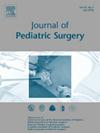Correlation of Tracheomalacia Severity With Esophageal Gap Length as Assessed by Ultrashort Echo-time MRI
IF 2.4
2区 医学
Q1 PEDIATRICS
引用次数: 0
Abstract
Introduction
Tracheomalacia severity is difficult to quantify, however, ultrashort echo-time MRI objectively quantifies tracheomalacia in infants without sedation, radiation, or intubation. Patients with tracheoesophageal fistula and esophageal atresia (TEF/EA) commonly have tracheomalacia, however, the relationship between tracheomalacia severity and esophageal atresia has not been well defined. The primary objective of this study was to establish the relationship between EA and tracheomalacia severity and identify possible predictors of tracheomalacia severity.
Methods
A retrospective review of neonates with TEF/EA who had previously undergone UTE MRI was performed. The trachea was divided into thirds. Maximal eccentricity in each third was calculated by measuring the anterior posterior dimension (MinD) and dividing it by the maximum width of the trachea (MaxD). Frequency of respiratory related admissions, number of upper respiratory infections, and number of steroids courses were quantified in addition to eccentricity in short and long gap esophageal atresia patients.
Results
A total of 16 TEF/EA patients were included. Patients with long gap esophageal atresia had more severe tracheomalacia than short gap as measured by eccentricity in the upper (0.60 vs 0.72, p = 0.03), middle (0.48 vs 0.61, p = 0.02), and lower (0.5 vs 0.65, p = 0.01) trachea. Long gap esophageal atresia patients had more frequent respiratory readmissions (1.87 admissions/year vs 0.54 admissions/year) (p = 0.03). Following TEF/EA repair the trachea was less eccentric in the upper third (0.64 pre, 0.79 post, p < 0.01) and more eccentric in the lower third (0.69 pre, 0.56 post, p < 0.01).
Conclusion
Differences in esophageal gap and repair status correlate with airway eccentricity and tracheomalacia symptoms.
Level of Evidence
4.
超短回波时间磁共振成像评估的气管瘘严重程度与食管间隙长度的相关性
简介:气管瘘的严重程度很难量化,但超短回波时间磁共振成像可客观地量化婴儿的气管瘘,而无需镇静、辐射或插管。气管食管瘘和食管闭锁(TEF/EA)患者通常伴有气管瘘,但气管瘘严重程度与食管闭锁之间的关系尚未明确。本研究的主要目的是确定食管闭锁与气管畸形严重程度之间的关系,并确定气管畸形严重程度的可能预测因素:方法:对之前接受过UTE磁共振成像的TEF/EA新生儿进行回顾性研究。气管被分成三份。通过测量前后尺寸(MinD)并除以气管最大宽度(MaxD),计算出每三分之一气管的最大偏心率。除偏心率外,还量化了短间隙和长间隙食管闭锁患者与呼吸道相关的入院次数、上呼吸道感染次数和类固醇治疗次数:共纳入16名TEF/EA患者。根据气管上段(0.60 vs 0.72,p = 0.03)、中段(0.48 vs 0.61,p = 0.02)和下段(0.5 vs 0.65,p = 0.01)的偏心率,长间隙食管闭锁患者的气管畸形比短间隙患者更严重。长间隙食管闭锁患者的呼吸道再住院率更高(1.87 次/年 vs 0.54 次/年)(p = 0.03)。TEF/EA 修复后,气管上三分之一的偏心程度较低(修复前为 0.64,修复后为 0.79,p 结论:TEF/EA 修复后,气管上三分之一的偏心程度较低(修复前为 0.64,修复后为 0.79):食管间隙和修复状态的差异与气道偏心和气管麻痹症状有关:4:
本文章由计算机程序翻译,如有差异,请以英文原文为准。
求助全文
约1分钟内获得全文
求助全文
来源期刊
CiteScore
1.10
自引率
12.50%
发文量
569
审稿时长
38 days
期刊介绍:
The journal presents original contributions as well as a complete international abstracts section and other special departments to provide the most current source of information and references in pediatric surgery. The journal is based on the need to improve the surgical care of infants and children, not only through advances in physiology, pathology and surgical techniques, but also by attention to the unique emotional and physical needs of the young patient.

 求助内容:
求助内容: 应助结果提醒方式:
应助结果提醒方式:


